The Kaveri Refresh 'Godavari' Review: Testing AMD's A10-7870K
by Ian Cutress on June 1, 2015 11:59 AM ESTGaming Benchmarks: High End
Alien: Isolation
If first person survival mixed with horror is your sort of thing, then Alien: Isolation, based off of the Alien franchise, should be an interesting title. Developed by The Creative Assembly and released in October 2014, Alien: Isolation has won numerous awards from Game Of The Year to several top 10s/25s and Best Horror titles, ratcheting up over a million sales by February 2015. Alien: Isolation uses a custom built engine which includes dynamic sound effects and should be fully multi-core enabled.
For low end graphics, we test at 720p with Ultra settings, whereas for mid and high range graphics we bump this up to 1080p, taking the average frame rate as our marker with a scripted version of the built-in benchmark.
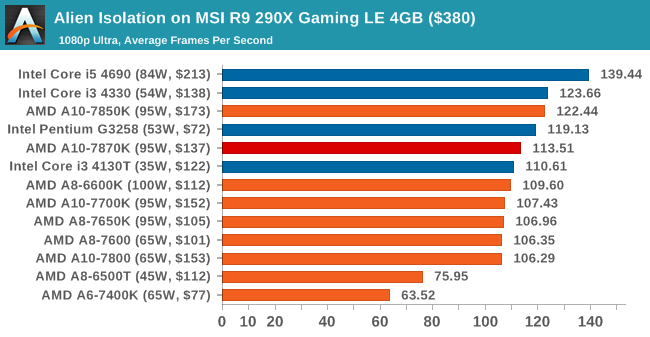

Total War: Attila
The Total War franchise moves on to Attila, another The Creative Assembly development, and is a stand-alone strategy title set in 395AD where the main story line lets the gamer take control of the leader of the Huns in order to conquer parts of the world. Graphically the game can render hundreds/thousands of units on screen at once, all with their individual actions and can put some of the big cards to task.
For low end graphics, we test at 720p with performance settings, recording the average frame rate. With mid and high range graphics, we test at 1080p with the quality setting. In both circumstances, unlimited video memory is enabled and the in-game scripted benchmark is used.

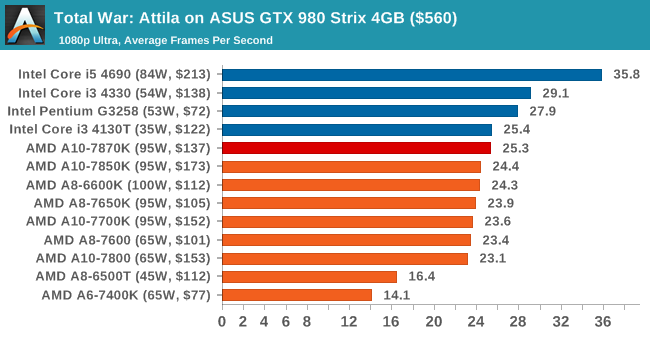
Grand Theft Auto V
The highly anticipated iteration of the Grand Theft Auto franchise finally hit the shelves on April 14th 2015, with both AMD and NVIDIA in tow to help optimize the title. GTA doesn’t provide graphical presets, but opens up the options to users and extends the boundaries by pushing even the hardest systems to the limit using Rockstar’s Advanced Game Engine. Whether the user is flying high in the mountains with long draw distances or dealing with assorted trash in the city, when cranked up to maximum it creates stunning visuals but hard work for both the CPU and the GPU.
For our test we have scripted a version of the in-game benchmark, relying only on the final part which combines a flight scene along with an in-city drive-by followed by a tanker explosion. For low end systems we test at 720p on the lowest settings, whereas mid and high end graphics play at 1080p with very high settings across the board. We record both the average frame rate and the percentage of frames under 60 FPS (16.6ms).
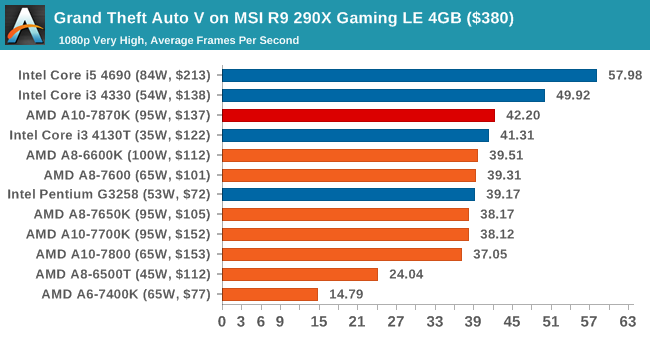
![Grand Theft Auto V on MSI R9 290X Gaming LE 4GB ($380) [Under 60 FPS]](https://images.anandtech.com/graphs/graph9307/74894.png)
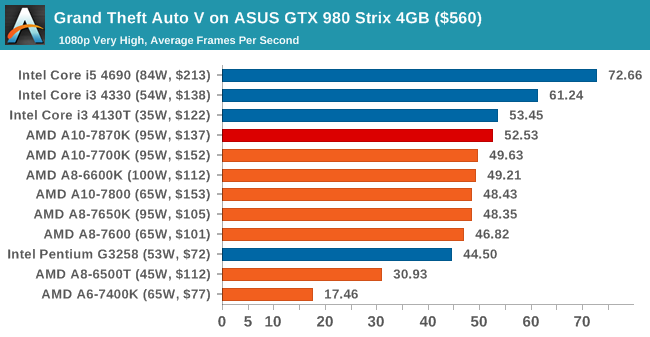
![Grand Theft Auto V on ASUS GTX 980 Strix 4GB ($560) [Under 60 FPS]](https://images.anandtech.com/graphs/graph9307/74906.png)
GRID: Autosport
No graphics tests are complete without some input from Codemasters and the EGO engine, which means for this round of testing we point towards GRID: Autosport, the next iteration in the GRID and racing genre. As with our previous racing testing, each update to the engine aims to add in effects, reflections, detail and realism, with Codemasters making ‘authenticity’ a main focal point for this version.
GRID’s benchmark mode is very flexible, and as a result we created a test race using a shortened version of the Red Bull Ring with twelve cars doing two laps. The car is focus starts last and is quite fast, but usually finishes second or third. For low end graphics we test at 1080p medium settings, whereas mid and high end graphics get the full 1080p maximum. Both the average and minimum frame rates are recorded.
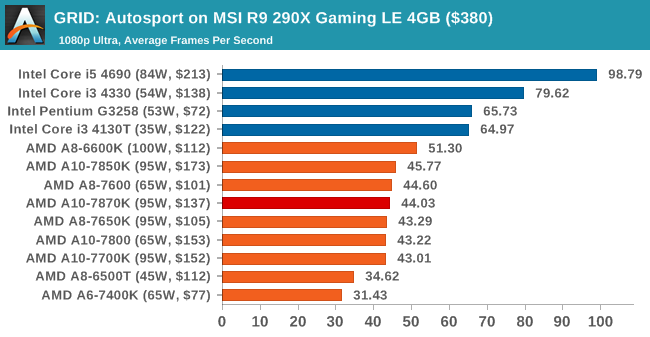
![GRID: Autosport on MSI R9 290X Gaming LE 4GB ($380) [Minimum FPS]](https://images.anandtech.com/graphs/graph9307/74896.png)
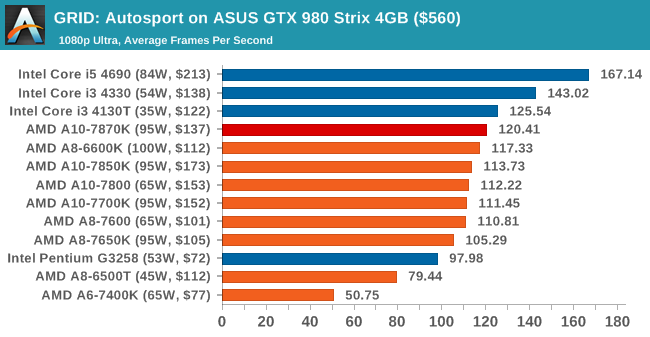
![GRID: Autosport on ASUS GTX 980 Strix 4GB ($560) [Minimum FPS]](https://images.anandtech.com/graphs/graph9307/74908.png)
Middle-Earth: Shadows of Mordor
The final title in our testing is another battle of system performance with the open world action-adventure title, Shadows of Mordor. Produced by Monolith using the LithTech Jupiter EX engine and numerous detail add-ons, SoM goes for detail and complexity to a large extent, despite having to be cut down from the original plans. The main story itself was written by the same writer as Red Dead Redemption, and it received Zero Punctuation’s Game of The Year in 2014.
For testing purposes, SoM gives a dynamic screen resolution setting, allowing us to render at high resolutions that are then scaled down to the monitor. As a result, we get several tests using the in-game benchmark. For low end graphics we examine at 720p with low settings, whereas mid and high end graphics get 1080p Ultra. The top graphics test is also redone at 3840x2160, also with Ultra settings, and we also test two cards at 4K where possible.
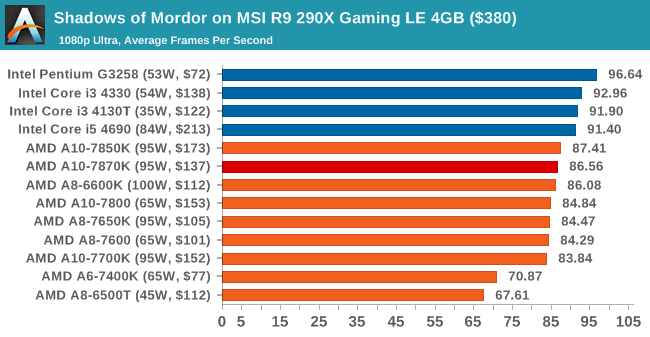
![Shadows of Mordor on MSI R9 290X Gaming LE 4GB ($380) [Minimum FPS]](https://images.anandtech.com/graphs/graph9307/74898.png)
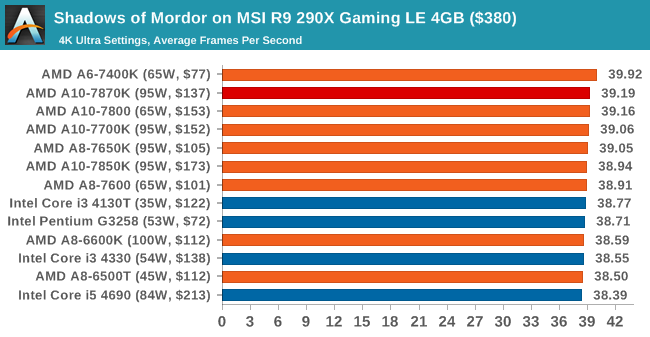
![Shadows of Mordor on MSI R9 290X Gaming LE 4GB ($380) [Minimum FPS]](https://images.anandtech.com/graphs/graph9307/74900.png)
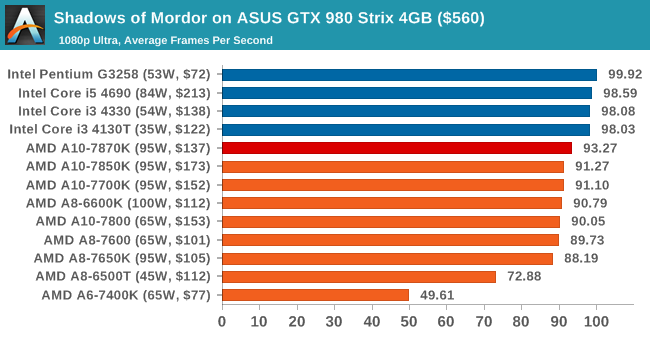
![Shadows of Mordor on ASUS GTX 980 Strix 4GB ($560) [Minimum FPS]](https://images.anandtech.com/graphs/graph9307/74910.png)
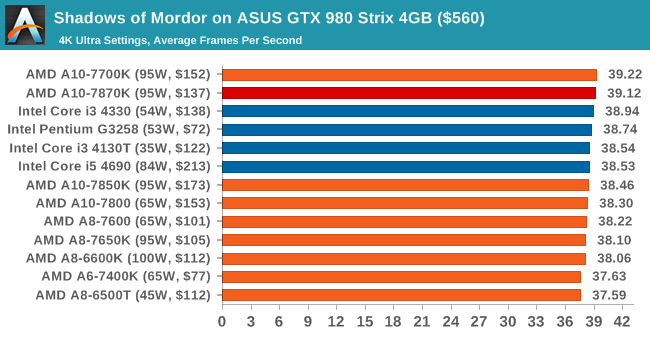
![Shadows of Mordor on ASUS GTX 980 Strix 4GB ($560) [Minimum FPS]](https://images.anandtech.com/graphs/graph9307/74912.png)
Shadows of Mordor, Dual-GPU
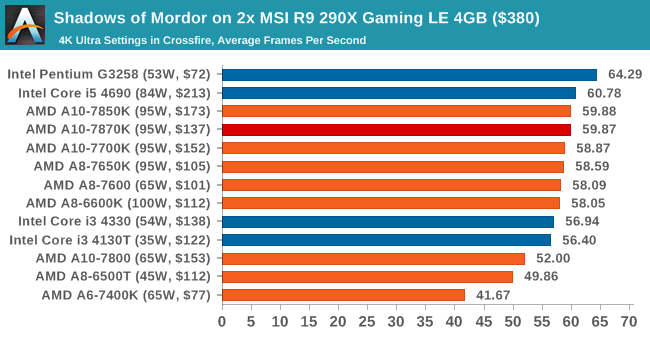
![Shadows of Mordor on 2x MSI R9 290X Gaming LE 4GB ($380) [Minimum FPS]](https://images.anandtech.com/graphs/graph9307/74902.png)
Conclusions on High-End Graphics
Moving to faster GPUs and higher resolutions pushes the burden away from the processor and more onto the graphics cards, so as a result some of the titles here, on some GPU combinations, see little gain moving up through the processor stack. That being said, some titles (like Alien Isolation, GRID and Mordor on a GTX 980) love the horse power under the hood and AMD can have a hard time keeping up here against the blue team. I wouldn’t be surprised if AMD is hoping that DirectX 12 levels the playing field in this regard.















140 Comments
View All Comments
nikaldro - Tuesday, June 2, 2015 - link
"IT'S CORE COUNT I TELL YOU!!! NOW GO AND BUY THAT XEON E7! GREAT VALUE!!!!"Crunchy005 - Monday, June 1, 2015 - link
Outside of CPU results the Gaming results are all over the place. The 7700k beats out the 7870k sometimes and the APUs beat our the i5 at times. There is so much difference between games at the low end it's ridiculous.Lolimaster - Monday, June 1, 2015 - link
Outside of some results I think the 7870K gpu boost is bottlenecked by DDR3 bandwith, how about testing the 7850K/7870K both with 2133 and 2400/2600 DDR3.Pissedoffyouth - Monday, June 1, 2015 - link
Sorry to be a pain, but I think you meant GDDR5 rather than GDDR3 on the first page.LarsBars - Monday, June 1, 2015 - link
Great review, great coverage. I've been looking over the smorgasbord of leaks for the past few weeks wondering what is real and what is fake. Thanks for your high standards in tech reporting.Shadowmaster625 - Monday, June 1, 2015 - link
Clearly there is something wrong, since a supposedly faster chip comes in slower on many benchmarks. Sunspider being the most egregious offender. Perhaps the instructions used in the sunspider benchmark cost a lot of power, which leads to even more pronounced throttling. At any rate, why is this throttling not mentioned in the article? What about the crazy high stock voltages? Very disappointing to say the least.dreamcat4 - Monday, June 1, 2015 - link
Regardless of the CPU it's the GTX 750ti you want and not the plain GTX 750.Also - there's no big issue to buy the Pentium if the CPU is socketed LGA1150. Then you can always upgrade it later on to something better / faster.
nikaldro - Monday, June 1, 2015 - link
Pentium + 750ti would cost quite a bit more than the APU, even considering a cheap H81 mobofrozentundra123456 - Monday, June 1, 2015 - link
Ehh, HD7770 has 25% more shaders than Kaveri, faster clock, and better bandwidth. So I would expect about 50% faster than Kaveri, and GTX750 (non-Ti) is still faster than HD7770. So 750 non-Ti is still a vast improvement over the igpu of Kaveri. If you are really budget limited and dont want a non-HT dual core, the Athlon X4 860k plus HD7770 or GTX750 will give far superior performance to an APU. Despite the repeated arguments in the gpu forums by AMD fans, you have to work really hard to construct a scenario in which an APU makes sense for gaming compared to a cheap cpu (pentuim, Athlon X4, or FX 6300) plus a hundred dollar discrete card.dreamcat4 - Monday, June 1, 2015 - link
Right. There are lower levels than the 750Ti. But it's always worth it and best to pay extra for 750Ti version. Because it's got a *significantly* better (non-marginal) price / performance ratio over the lower slots of GTX 750, 740, or 730. Making the 750Ti always best value choice amongst those.AMD APU only makes sense for certain low-to-midrange mobo upgrades. E.g. just upgrading only the mobo+CPU only. And regardless of that possibility the AMD is never going to be as power performant (the TDPs). Which does still matter, the fan noise, case thermals, throttling etc.
The more other components you upgrade at same time (e.g. PSU, case, monitor etc). Then the less money is being saved with APU route = diminishing returns. And it's really not typical to 'just upgrade only the mobo+cpu' without also replacing other components too. Often monitor, storage, ram. So most times that puts all of these AMD APUs in some kind of a general 'grey area'. And that's being nice about it, ignoring both the higher TDP and also the poorer single-threaded performance.